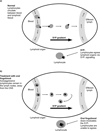Mechanism of action of oral fingolimod (FTY720) in multiple sclerosis
- PMID: 20061941
- PMCID: PMC2859693
- DOI: 10.1097/WNF.0b013e3181cbf825
Mechanism of action of oral fingolimod (FTY720) in multiple sclerosis
Abstract
Fingolimod (FTY720) is a first-in-class orally bioavailable compound that has shown efficacy in advanced clinical trials for the treatment of multiple sclerosis (MS). In vivo, fingolimod is phosphorylated to form fingolimod-phosphate, which resembles naturally occurring sphingosine 1-phosphate (S1P), an extracellular lipid mediator whose major effects are mediated by cognate G protein-coupled receptors. There are at least 5 S1P receptor subtypes, known as S1P subtypes 1-5 (S1P1-5), 4 of which bind fingolimod-phosphate. These receptors are expressed on a wide range of cells that are involved in many biological processes relevant to MS. S1P1 plays a key role in the immune system, regulating lymphocyte egress from lymphoid tissues into the circulation. Fingolimod-phosphate initially activates lymphocyte S1P1 via high-affinity receptor binding yet subsequently induces S1P1 down-regulation that prevents lymphocyte egress from lymphoid tissues, thereby reducing autoaggressive lymphocyte infiltration into the central nervous system (CNS). S1P receptors are also expressed by many CNS cell types and have been shown to influence cell proliferation, morphology, and migration. Fingolimod crosses the blood-brain barrier and may therefore have direct CNS effects, distinguishing it from immunologically targeted MS therapies. Prophylactic administration of fingolimod to animals with experimental autoimmune encephalitis (EAE), a model of MS, completely prevents development of EAE features, whereas therapeutic administration significantly reduces clinical severity of EAE. Therapeutic efficacy observed in animal studies has been substantiated in phase 2 and 3 trials involving patients with relapsing or relapsing-remitting MS.
Figures





References
-
- Confavreux C, Vukusic S. Accumulation of irreversible disability in multiple sclerosis: from epidemiology to treatment. Clin Neurol Neurosurg. 2006;108:327–332. - PubMed
-
- Noseworthy JH, Luchinetti C, Rodriguez M, et al. Multiple Sclerosis. New England Journal Medicine. 2000;343:938–952. - PubMed
-
- World Health Organization. Neurology atlas. 2004. http://www.who.int/mental_health/neurology/neurogy_atlas_review_referenc....
-
- Dev KK, Mullershausen F, Mattes H, et al. Brain sphingosine-1-phosphate receptors: implication for FTY720 in the treatment of multiple sclerosis. Pharmacol Ther. 2008;117(1):77–93. - PubMed
-
- Frohman EM, Racke MK, Raine CS. Multiple sclerosis--the plaque and its pathogenesis. N Engl J Med. 2006;354(9):942–955. - PubMed
Publication types
MeSH terms
Substances
Grants and funding
LinkOut - more resources
Full Text Sources
Other Literature Sources
Medical
Molecular Biology Databases

